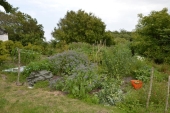
 4
4




 7
7




Come join me at www.peacockorchard.com
 7
7




When you reach your lowest point, you are open to the greatest change.
-Avatar Aang




Other people may reject you but if you lie in the forest floor for long enough the moss and fungi will accept you as one of their own!
 2
2




Living a life that requires no vacation.

 7
7




Deborah Epstein wrote:I planted lots of crimson clover last fall as a cover crop. Then I neglected to cut it down while it was small and it has flowered. It's totally gorgeous. Or it was. I just pulled it all up to use it as slow-release nitrogen in vegetable beds. partly because I remember hearing not to let it go to seed because it will spread like mad. Is this true? (Zone 8b, Vashon Island, Washington)
Since they flowered, I noticed that the bees loved them so I was ambivalent about pulling them up. Even though it's after the fact I thought I might check for next year's purposes... Next year, can/should I plant some for the bees in a place I don't need to pull them up, or will I regret it?
Also, I didn't see root nodules like I see on my fava beans, and they were planted together, so I assume they don't make them. My (possibly incorrect) understanding about using beans for nitrogen fixation, is that you need to cut them at ground level and leave the roots in place, and that's how they'll release their fixed nitrogen. For crimson clover, do I likewise need to leave the roots in place? I didn't this time because I needed to clean some things up, and figured that chop/drop into various beds (or my compost pile) will ultimately accomplish the same goal.
Thanks for helping me understand!
Deborah
List of Bryant RedHawk's Epic Soil Series Threads We love visitors, that's why we live in a secluded cabin deep in the woods. "Buzzard's Roost (Asnikiye Heca) Farm." Promoting permaculture to save our planet.
 3
3




Dennis Bangham wrote:What would you do if you lived in a suburb? Would clover or any others be a good cover and not invade the neighbors? I just put down 8 to 10 inches of chips and want to plant a hot summer cover crop that can survive North Alabama heat.
A build too cool to miss:Mike's GreenhouseA great example:Joseph's Garden
All the soil info you'll ever need:
Redhawk's excellent soil-building series





 2
2




Dennis Bangham wrote:What would you do if you lived in a suburb? Would clover or any others be a good cover and not invade the neighbors? I just put down 8 to 10 inches of chips and want to plant a hot summer cover crop that can survive North Alabama heat.
When you reach your lowest point, you are open to the greatest change.
-Avatar Aang
 8
8




![Filename: 1.jpg
Description: Red Clover [Thumbnail for 1.jpg]](/t/113296/a/80057/1.jpg)














Some places need to be wild




Deborah Epstein wrote:I planted lots of crimson clover last fall as a cover crop. Then I neglected to cut it down while it was small and it has flowered. It's totally gorgeous. Or it was. I just pulled it all up to use it as slow-release nitrogen in vegetable beds. partly because I remember hearing not to let it go to seed because it will spread like mad. Is this true? (Zone 8b, Vashon Island, Washington)
Since they flowered, I noticed that the bees loved them so I was ambivalent about pulling them up. Even though it's after the fact I thought I might check for next year's purposes... Next year, can/should I plant some for the bees in a place I don't need to pull them up, or will I regret it?
Also, I didn't see root nodules like I see on my fava beans, and they were planted together, so I assume they don't make them. My (possibly incorrect) understanding about using beans for nitrogen fixation, is that you need to cut them at ground level and leave the roots in place, and that's how they'll release their fixed nitrogen. For crimson clover, do I likewise need to leave the roots in place? I didn't this time because I needed to clean some things up, and figured that chop/drop into various beds (or my compost pile) will ultimately accomplish the same goal.
Thanks for helping me understand!
Deborah





|
Police line, do not cross. Well, this tiny ad can go through:
The new gardening playing cards kickstarter is now live!
https://www.kickstarter.com/projects/paulwheaton/garden-cards
|



